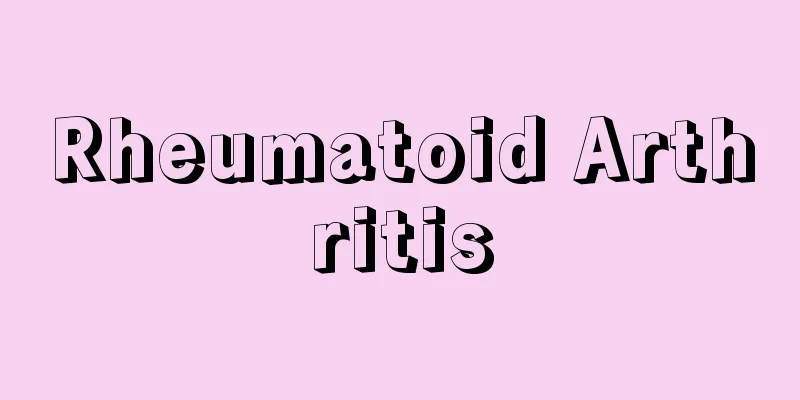Rheumatoid Arthritis

|
What is rheumatoid arthritis? Symptoms of rheumatoid arthritis Causes of rheumatoid arthritis Testing and diagnosis Treatment of rheumatoid arthritis Precautions in daily life What is rheumatoid arthritis? Rheumatoid arthritis, whose main symptom is arthritis, is a disease in which inflammation occurs in the joints due to immune abnormalities throughout the body, causing joint swelling and pain. The disease progresses gradually, and over a long period of time, the joints become deformed, causing serious functional disorders. Rheumatoid arthritis is common among women of an age who are busy with housework and child-rearing, and is a disease that has a large social impact. When people hear the word "rheumatism," they tend to think of it vaguely as a disease that causes pain in the joints of the body. In fact, such diseases are collectively called rheumatic diseases, but there are many different types. Among these, rheumatoid arthritis is a representative disease and is also called rheumatism in the narrow sense. It was also called chronic rheumatoid arthritis, but was renamed in 2002, so we will refer to it as rheumatoid arthritis and explain it here. Rheumatoid arthritis is a disease that affects all joints in the body. As shown in the upper left of the figure "Normal joint and joint affected by rheumatoid arthritis," a joint is a part that connects two bones, but between the bones there is cartilage and synovial fluid that act as a cushion. This joint is surrounded by a membrane-like structure called the joint capsule, and the inside of this structure is made up of fibrous tissue called the synovial membrane. The synovial membrane is a tissue similar to the lining of clothing, and in rheumatoid arthritis, this synovial membrane is affected. When synovitis occurs, cells such as white blood cells gather and the synovial cells themselves increase in number, causing the synovial membrane to proliferate in folds and form a tissue called pannus (bottom left of the figure ``Normal joint and joint affected by rheumatism''). This pannus dissolves and erodes the surrounding tissues while secreting various substances, dissolving cartilage and eroding bone, eventually causing joint deformation (right side of the figure "Normal joint and joint affected by rheumatoid arthritis"). This is rheumatoid arthritis. ●Who is it most likely to affect? Rheumatoid arthritis is a disease that affects women three to four times more than men. It can develop in people of any age from their 20s to their 70s, but the age group most likely to develop it is people in their 40s. It is often diagnosed after childbirth or around menopause, and the onset of the disease may be related to the balance of female hormones. It also seems to be more common in winter. Approximately 20% of patients who visit the clinic have a close relative with rheumatoid arthritis, but compared with high blood pressure and diabetes, the genetic influence in rheumatoid arthritis is clearly weak and it should be considered that there is no clear hereditary role. Symptoms of rheumatoid arthritis Various symptoms occur What is the progress? Classification of progression Various symptoms occur In many cases , joint pain and swelling may be present at first. This may begin in the small joints of the hands and fingers, and may progress to the wrists, shoulders, knees, ankles, and other joints. The joints of the fingers, the PIP joints and MP joints, which are the second and third joints from the fingertip, are easily affected and become swollen in a spindle shape. You may also experience a symptom called "morning stiffness." This is when you wake up in the morning and try to clench your hand, but the joints in your fingers are so stiff that you have to use force to bend them, but this goes away after you move your hands for a while. Even healthy people will experience some stiffness in their hands the morning after using them a lot. However, if your hands become stiff even without using them, and the stiffness continues for more than 30 minutes after waking up, it is likely that you have "morning stiffness." The swelling and pain in the joints will continue chronically, and if left untreated, the joints will gradually become deformed and lose function. The muscles around the joints atrophy as a result of the joints becoming less mobile. Symptoms other than in the joints In aggressive rheumatoid arthritis, lumps called rheumatoid nodules can develop under the skin. They are often found 3-4 cm from the tip of the elbow (the elbow head), on the straight side, but they are not particularly painful and no treatment is required. In bedridden patients, they can develop around the back of the head or sacrum. In addition to the joints, the lungs, kidneys, heart, nerves, and eyes may also be affected. As for lung lesions, interstitial pneumonia ("What is interstitial pneumonia?") and pulmonary fibrosis appear in 5 to 10% of patients. They are particularly common in relatively elderly male patients with rheumatoid arthritis who have high rheumatoid factor levels. Rheumatoid factor is an antibody that attacks part of the protein that produces antibodies called immunoglobulins as an antigen. This lung lesion affects the prognosis of patients with long-standing rheumatoid arthritis. It can also cause pleural thickening and pleurisy. The most common kidney lesions are proteinuria and hematuria, but many of these appear to be caused by rheumatoid medication. In patients with long-standing rheumatoid arthritis, a substance called amyloid can accumulate in the kidneys, leading to kidney failure. In addition, it may cause polyneuritis, pericarditis, episcleritis, and vasculitis of the skin (malignant rheumatoid arthritis). The diagram "Distribution of joints commonly affected by rheumatoid arthritis" shows the joints commonly affected by rheumatoid arthritis. Even if the disease begins with pain and swelling in a few joints, more and more joints will gradually be affected. While joint pain and swelling persist, a tissue called the synovial membrane continues to proliferate and dissolve the cartilage and bone. Therefore, if adequate treatment is not given, the joint will gradually become deformed. It will gradually become more difficult to move (restricted range of motion), and eventually the joint will become deformed, stiffen and unable to move, or become unstable and unable to exert force. Deformities of the fingers are characteristic and are called swan-neck deformity (figure 2: "deformed finger joints"), buttonhole deformity, and ulnar deviation. The toes may develop deformities such as hallux valgus, in which the big toe bends inward, or hammer toe, in which the tip of the finger bends downward like a hammer. The range of motion of the wrist joint may become limited, and the tendons that straighten the fourth finger (ring finger) and fifth finger (little finger) may become torn, making it impossible to straighten them. When the range of motion of the elbow joint becomes limited, it becomes difficult to reach the face, making daily life very difficult. The hip and knee joints also become less mobile, and this, combined with deformation of the foot joints and toes, makes walking difficult. Rheumatoid arthritis does not affect the spine much, but it can affect the atlantoaxial joint between the first and second cervical vertebrae, putting pressure on the spinal cord. This is seen in advanced rheumatoid arthritis, causing neck pain and instability. If the deformation progresses, it may cause spinal paralysis and respiratory paralysis. In this way, the joints of rheumatoid arthritis patients become deformed as the disease progresses, but there is also a type of deformity known as the mutilation type, in which the proliferation of synovial membrane causes the joint capsule and ligaments to stop functioning, causing the joint to become unstable. If rheumatoid arthritis continues for a long time, symptoms other than those affecting the joints will increase, as mentioned above. In particular, breathing difficulties due to pulmonary fibrosis and kidney damage due to the accumulation of amyloid should be taken seriously. Rheumatoid arthritis has been considered one of the most incurable diseases, and it has been said that there is no cure. Even today, the exact cause is still unknown, and there is no way to completely cure it. However, many effective treatments have been developed that can significantly suppress the activity of rheumatoid arthritis and make you almost forget you have the disease. We cannot be optimistic, but we should not be pessimistic either. I would like you to understand the current state of medical science. The progression of joint destruction caused by rheumatoid arthritis varies greatly from person to person. Based on the progression of the disease, it is classified into the following three types. Rapidly progressive type: After the onset of the disease, inflammation progresses rapidly, and joint deformation can be seen as early as one year after the onset of the disease. Powerful anti-rheumatic therapy is required from an early stage. Approximately 10% of all cases are of this type. Multi-cycle type: This type progresses gradually with periods of improvement and worsening, and accounts for approximately 70% of all cases. ●Monocyclic type: Arthritis is seen for a while after the onset of the disease, but the symptoms subside within about six months to a year. There is almost no joint destruction. This type accounts for about 20% of all cases. Causes of rheumatoid arthritis ◎A disease of unknown cause It is not yet fully understood why chronic inflammation occurs in the synovial membrane. However, the phenomenon of "inflammation" occurs continuously in the joints of people with rheumatoid arthritis. Inflammation is a reaction that occurs when the body tries to repair an injury to a part of it. For example, when bacteria infect the tonsils at the back of the throat, white blood cells, which are the body's defense force, gather in the tonsils and try to kill and expel the bacteria that have invaded from outside. As a result, the tonsils become red, swollen, and painful. This is inflammation of the tonsils, known as tonsillitis. In addition, after you cut your finger with a knife and it starts to bleed, white blood cells and fibroblasts gather to repair the damaged tissue. This is also inflammation. In other words, the inflammatory response is one of the ways the human body protects itself. Arthritis is when joints become swollen and painful, and this is a condition in which an inflammatory reaction occurs in the joints. There are various causes of arthritis, including osteoarthritis caused by the transformation of cartilage with aging, septic arthritis caused by bacterial infection, and gout caused by uric acid crystals. However, we still don't know why the arthritis of rheumatoid arthritis occurs. We don't know whether inflammation occurs in an attempt to expel something that has entered the body from outside, whether the body mistakes a part of its own body for a foreign body substance and reacts to it, or whether some other mechanism is at work. However, it is certain that in rheumatoid arthritis joints, some kind of external stimulus triggers the immune system to become activated, causing inflammation and proliferation of the synovial membrane, resulting in destruction and deformation of the joint. Although we have yet to discover a clear cause or cure, research into rheumatoid arthritis has made great strides recently, and I believe that the cause will become clear in the near future. Testing and diagnosis ◎Blood tests and X-rays ● Blood test Rheumatoid factor test If there is an antibody against a protein called IgG in the body, the result of this test will be positive. The positive rate is about 80% in patients with rheumatoid arthritis. Even if they have the same rheumatoid arthritis, people who test positive for this test seem to have a higher chance of developing the disease than those who test negative. This test is sometimes called the rheumatoid reaction, but this name can be misleading. For example, tuberculosis bacteria are the cause of the disease, so if tuberculosis bacteria are found in sputum, the diagnosis is pulmonary tuberculosis. However, rheumatoid factor is not the cause of rheumatoid arthritis. A positive test result does not mean that you have rheumatoid arthritis. This factor is often found in patients with rheumatoid arthritis, so it can be an aid in diagnosis, but it can also be positive in patients with collagen disease and chronic hepatitis. Even in completely healthy people, 5% will test positive, and the percentage increases in the elderly. Also, there are several methods for measuring rheumatoid factor levels, and the results vary. Please listen carefully to your doctor's explanations and understand the test results. Both the erythrocyte sedimentation rate (ESR) and CRP change when there is inflammation in the body. A normal ESR is 20mm or less per hour, and a normal CRP (C-reactive protein) is 0.5mg or less per dL. These values become high with any type of inflammation, so they become abnormal with pneumonia, gastroenteritis, etc. With rheumatoid arthritis, the more severe the condition, the higher the values become. In active rheumatoid arthritis, the erythrocyte sedimentation rate may reach 100mm/hour or more, and the CRP may reach 10mg/dl or more. In addition, tests for immune system substances such as immunoglobulins and antinuclear antibodies, blood tests for red blood cells, white blood cells, and platelets, and biochemical tests (tests to look at the circulation of materials in the body) such as alkaline phosphatase (an enzyme involved in energy production) often reveal abnormalities. ●In the early stages of the disease, X-rays show swelling of the soft tissue surrounding the joints. As the disease progresses, the bones become thinner, the space between the bones (joint space) narrows, and moth-hole-like changes in the bones, known as bone erosion, can be seen. Bone erosion occurs when the synovial membrane proliferates and begins to erode bone, and occurs in approximately 60% of patients within one year of onset of the disease. Diagnosis of rheumatoid arthritis If symptoms of swelling, fever, and pain in multiple joints, especially the same joints on both sides, continue for more than six weeks, rheumatoid arthritis is suspected. If you have stiffness, a positive blood test for rheumatoid factor, or a high erythrocyte sedimentation rate or CRP, you are more likely to have rheumatoid arthritis. If X-rays of the hands and feet show characteristic bone changes called bone erosions, you are almost certain to have rheumatoid arthritis. One diagnostic standard is the classification criteria established by the American College of Rheumatology in 1987 (see table "American College of Rheumatology Classification Criteria for Rheumatoid Arthritis (Revised in 1987)"). Doctors treat patients who meet these criteria as having rheumatoid arthritis. ● Diseases that are easily confused: Diseases that cause arthritis in multiple joints include osteoarthritis, rheumatic fever ("rheumatic fever"), gout ("hyperuricemia/gout"), psoriatic arthritis ("psoriatic arthritis"), and Behcet's disease ("Behcet's disease"). Osteoarthritis, which occurs in the hands and fingers around age 50-60 and causes swelling and tingling pain, is a type of arthritis that is easily mistaken for rheumatoid arthritis. When osteoarthritis occurs in the first (DIP) joint, it is called Heberden's nodes, and when it occurs in the second (PIP) joint, it is called Bouchard's nodes. This disease is relatively easy to diagnose based on characteristic bone X-ray images, and although there is no specific treatment, symptoms usually improve within a year. Diseases that cause stiffness and numbness include cervical spondylosis (cervical spondylosis), lumbar spondylosis (lumbar spondylosis), and diabetes. In particular, cervical spondylosis can cause stiffness in the fingers, similar to the morning stiffness of rheumatoid arthritis. Diseases that cause joint pain include osteoporosis ("osteoporosis"), osteoarthritis ("What is osteoarthritis?"), and cervical spondylosis. Rheumatoid factor positive diseases include systemic lupus erythematosus ("systemic lupus erythematosus (SLE)"), collagen diseases such as Sjogren's syndrome ("Sjogren's syndrome"), chronic hepatitis ("chronic hepatitis"), and chronic infections. Rheumatic fever, which is caused by infection with streptococcus and causes valvular heart disease in a high rate, is a completely different disease from rheumatoid arthritis. Rheumatoid arthritis is rarely associated with valvular disease. Treatment of rheumatoid arthritis ◎Medications and orthopedic surgery are the main focus of treatment. We will explain the goals of treatment, the medical department to be visited, and the types of treatment. Treatment goals Which department should I visit? Drug treatment Surgical treatment Specific treatment ●Treatment goals Currently, the treatment goals for rheumatoid arthritis are limited to the following: 1) Medications are used to calm inflammation and immune disorders caused by rheumatoid arthritis. ② Maintain joint function and prevent deformation. ③If joint function declines, it can be restored through surgery or other means. However, the treatment plan for rheumatoid arthritis varies depending on the person and the time of treatment. It is a case-by-case basis, and a treatment that worked for one person may not necessarily work for another person. There are many cases where kindness such as "This treatment worked for me, so you should try it too" backfires. It is important not to make your own decisions, so be sure to follow your doctor's instructions carefully. Also, please understand that "relieving pain is not the purpose of treatment." It is understandable that you would want to just do something about the pain, but even if you suppress the pain alone, you cannot suppress the arthritis, and you cannot prevent the deformation of the joints. It is important to treat the arthritis, which is the cause of the pain. ●Which department should I visit? Rheumatoid arthritis causes long-term joint damage, so it has been treated by orthopedic surgeons and some internists. However, since 1996, the Ministry of Health and Welfare (now the Ministry of Health, Labor and Welfare) has given permission for the name "Rheumatology" to be used as a medical specialty, making it more convenient to visit a doctor. There are still not many medical institutions that have a rheumatology department on their sign, but many of the doctors who call themselves rheumatologists have trained as internists or orthopedic surgeons and have treated rheumatoid arthritis, other joint diseases, and collagen diseases. With the recognition of rheumatology departments, there are now facilities to treat patients with suspected rheumatoid arthritis and related diseases, but the department that a patient should visit varies slightly depending on their condition. Patients who have just developed the disease or who have multiple co-existing illnesses should visit an internal medicine or rheumatology department, while patients with severe joint deformity who are likely to require surgery should visit an orthopedic surgeon or rheumatology department. ● Drug treatment Drug treatment is divided into two stages: treatment to suppress inflammation and relieve pain, and treatment to correct immune abnormalities. <Medicines that reduce inflammation and relieve pain> Nonsteroidal anti-inflammatory drugs are known as "anti-inflammatory analgesics." There are many different types, and the same drug can be taken orally, as a suppository, topical agent, or ointment, and there are many different dosage forms. These can ease joint pain, swelling, and morning stiffness, but they are only symptomatic treatments that suppress the symptoms, so they cannot prevent the joints from deforming. If you are clearly diagnosed with rheumatoid arthritis, you will need to use anti-rheumatic drugs in combination. A common side effect of nonsteroidal anti-inflammatory drugs is gastrointestinal disorders. It is better to take them with stomach medicine. Depending on the drug, swelling, rashes, photosensitivity, etc. may occur. Recently, many drugs with different characteristics have been developed, such as drugs with strong analgesic effects, drugs with a long duration of action, and drugs that cause fewer gastrointestinal disorders. Steroid drugs (adrenal cortex hormone drugs) are drugs with strong anti-inflammatory effects. There are many types, such as prednisolone (brand name Prednisone) and dexamethasone (brand name Rinderon), and they are available as oral or injectable medications. This is a drug that dramatically relieves arthritis, and in cases where the arthritis is severe in the early stages of the disease, steroid drugs can be used to effectively suppress inflammation, making it possible to prevent bone destruction. Steroid drugs are also effective for fever and weight loss, so they are also necessary when there are systemic symptoms, interstitial pneumonia, vasculitis, and other symptoms other than those affecting the joints. Steroid injections are also very effective in cases of fluid accumulation in joints (edema). There is also an injectable steroid called dexamethasone palmitate (brand name Limethasone) that is designed to be absorbed only in areas with severe inflammation. Steroid drugs are also drugs that suppress inflammation, and do not cure the cause. Steroid drugs are a double-edged sword. If you take more than necessary for a long period of time, you may develop a moon face, a round face, osteoporosis, stomach ulcers, diabetes, etc. These side effects can occur if you take steroids casually to relieve pain even when the inflammation is not severe, but if your rheumatoid arthritis is severe and you are taking the minimum amount of steroids necessary, side effects are seldom seen. The usual dosage for rheumatoid arthritis is one tablet (5 mg) of prednisone per day. Doses below this amount do not cause many side effects. If the systemic symptoms are severe or accompanied by symptoms such as vasculitis, 2 to 4 tablets may be used for a short period of time only. As a rule, it should be taken once in the morning, but if it is divided into two doses, take a larger dose in the morning. Steroids are one of the most obvious drugs that can be either a poison or a medicine depending on how they are used, so when treating rheumatoid arthritis, it is important not to view steroids as harmful more than necessary. <Drugs that correct immune disorders> These drugs are called antirheumatic drugs, delayed-acting antirheumatic drugs, or DMARDs, and include immunomodulators and immunosuppressants. Gold injections Gold preparations (brand name Shiozoru) are the oldest and most effective anti-rheumatic drugs. Usually, 10 to 25 mg is injected intramuscularly every 2 to 4 weeks. Effects will appear within 3 to 4 months of starting use, but even in effective cases, the drug may no longer be effective after 5 years or more. The most common side effects are rash, mild blood abnormalities such as leukopenia and thrombocytopenia, and kidney disorders such as proteinuria and hematuria. In rare cases, interstitial pneumonia may occur. Oral gold supplements (Auranofin, brand name Ridora) are taken at a dose of 6 mg (2 tablets) per day. They are used in the early stages of the disease or when inflammation is relatively weak. Serious side effects are unlikely to occur, but digestive symptoms, especially diarrhea, are common. The SH compounds D-penicillamine (brand name Metalcaptase) and bucillamine (brand name Rimatil) are both effective anti-rheumatic drugs that show results within 3 months of starting use, with an efficacy rate of about 70%. Start with 100mg per day and increase the dosage while monitoring the effects and side effects. Both drugs have side effects such as rash and proteinuria, which usually appear 6 to 9 months after starting treatment and disappear when the drugs are discontinued. Salazosulfapyridine (sulfasalazine) preparations (brand name Azulfidine EN) take effect relatively quickly, becoming effective within 4 to 6 weeks of starting use, but their effectiveness also decreases more quickly than other anti-rheumatic drugs. The usual dosage is 2 tablets (1g) per day. Side effects may include abdominal discomfort, headache, hives-like rash, and hepatitis-like symptoms with fever and jaundice that may occur shortly after starting the drug. In addition, the immunomodulatory drug lobenzarit disodium (trade name Carphenil) and actarit (trade name Movar-Ochre), and the immunosuppressant mizoribine (trade name Predinin) are also used as anti-rheumatic drugs. For severe rheumatoid arthritis, immunosuppressants such as cyclophosphamide (brand name Endoxan) and azathioprine (brand name Imuran) may be used. Methotrexate preparations (trade name Methotrexate) are a type of immunosuppressant that strongly suppresses cell proliferation and is used as an anticancer drug, but it has been found that they are also effective against rheumatoid arthritis in very small amounts. It is currently considered to be the most effective drug and is used as the mainstay of drug treatment for rheumatoid arthritis. Methotrexate is taken in a one-week cycle of 2 mg per capsule, taken three times at 12-hour intervals from the first day of administration through the second day, followed by a five-day break. The dosage may change depending on symptoms, age, and physical condition, but if the dosage is increased, it should be limited to 8 mg per week, three times at 12-hour intervals. As a general rule, it should not be used in women who may be pregnant. Side effects include liver damage and, in rare cases, rashes and interstitial pneumonia. ●Surgical treatment There are two types of surgery: synovectomy, which is performed to treat the disease, and surgery to reconstruct bone and joint function that has been destroyed by the disease. Improved surgical techniques have resulted in a significant improvement in joint function, significantly improving the quality of life (QOL) of patients. However, unlike surgery to remove benign tumors, early surgery does not "cur" rheumatoid arthritis. Each surgeries have their own characteristics, and there is a timing for the surgery. If it is too early, you may have to undergo another operation, and if it is too late, the area of surgery will be wider, and the condition after surgery is not good. 1) Synovectomy (Katsumakusetsu Jojutsu) This surgery aims to prevent the joint from being destroyed by surgically peering through synovium that has grown in joints. Using an endoscope called an arthroscope reduces damage from surgery. This is for early to mid-stage rheumatoid arthritis, where a small number of joints such as the knees are severely malfunctioning. However, the synovium often regenerates and does not cure it. 2. Reconstruction of bone and joint function This is done to reconstruct physical functions that have become difficult to carry out daily activities due to joint destruction or damage to the tendon. Arthroplasty is performed when rheumatoid arthritis progresses, the joint cartilage disappears, and the pain caused by joint deformity is severe, and daily activities are significantly limited. The knee and hip joints are often used, and surgery results are stable, but this is not yet common in joints such as the elbow and shoulders. Arthroplasty (Arthroplasty) This is a surgery performed to correct the deformity and relieve the pain in cases of severe pain due to deformation such as subluxation in which the joint is about to fall apart, or hallux valgus or toes deformity. The surgical method has also been improved, and the results of the treatment have also been improved. Cervical fusion In advanced rheumatoid arthritis , subluxation occurs in the atlantoaxial joint of the first and second cervical vertebrae, which can compress the spinal cord. If the deformity becomes severe, it can cause spinal cord palsy and respiratory palsy, and surgery to fix the spinal cord may be performed. Other surgeries may be performed to fix joints that are painful due to deformity, to sew or implant torn tendons, and to release nerves that have been compressed by deformed joints. ●Specific treatment If you have a reliable diagnosis of rheumatoid arthritis and you have active arthritis, you will need to take antirheumatic medications. If antirheumatic medications can adequately suppress arthritis, you can also prevent bone destruction. In some cases, steroids are also used in conjunction. Even if anti-rheumatic drugs work, if you stop using it completely, it often worsens, and it seems that it is better to continue using even small amounts. If the antirheumatic drugs you used don't work, you can switch to another type of antirheumatic drug. Nonsteroidal anti-inflammatory drugs are taken to relieve joint pain, but if antirheumatic drugs work, you can reduce or discontinue the dose. It is best to take blood and urine tests once every 1-2 months while taking anti-rheumatic medications, and chest x-rays should also be performed once a year. Even after such treatment, if the joints are destructed further, surgery will be performed to reconstruct the function of the bone and joints. Care for everyday life ◎We will proceed with the following points as basic therapy and rehabilitation rehabilitation treatment. ●Rheumatoid arthritis in the whole body is a disease that drains physical strength, and in order to control the illness, it is necessary to make an effort to prevent a decline in physical strength. To do this, it is important to avoid overwork, relaxation both physically and mentally, and avoid eating a picky diet. If your joints are swollen and have a fever, rest the joint. If you have a mild fever or lose weight because you lose your appetite, you may need to rest your whole body, and you may need to be hospitalized. ●Rest in the joints and exercise therapy To rest in the joints, make sure to keep the joints extended to the wrists, elbows, and knees in a state of bent at right angles. In addition, care must be taken to prevent excessive force from being applied to the joints. However, if you leave a painful joint for a long time, the joint will become inactive, so exercise therapy is also important. The balance between resting and exercise is extremely difficult, but in the afternoon, stiffness usually subsides and joint pain will alleviate, so make sure to exercise appropriately. In principle, it is important to do the following properly to prevent joint deformation: 1. Stretch and bend all joints several times a day (maintain and improve range of motion). ② People with knee pain should perform exercises to strengthen the muscle strength of the muscles above the knee (quadriceps) (maintaining and improving muscle strength). ③People with joint pain in their feet should wear loose shoes. ④Obese people should lose weight as quickly as possible and reach normal weight. ⑤If the joint is about to deform, move in the opposite direction to the direction of bend. ● Orthotic therapy Orthotics may be used to prevent deformation of the fingers and toes. Also, if the cervical vertebrae becomes unstable, wear a cervical vertebrae when going out. A variety of self-help tools are available on sale, such as lever-type water taps and long handle brushes, so you can use them in case your body is unable to move around due to joint deformation. However, if you receive the help of self-help equipment early, it can actually speed up joint function degradation, so caution is required. ●Diet therapy There are no foods that are good or bad for rheumatoid arthritis. Avoid eating a picky diet and eat a well-balanced diet. Women in particular are prone to anemia and osteoporosis (osteoporosis), so be sure to eat foods that are high in iron and calcium. ◎Pregnancy and childbirth Rheumatoid arthritis is common among women of age where pregnancy is possible, and pregnancy and childbirth are often a problem. If you wish to become pregnant, it is best to suspend anti-rheumatic medications and develop a planned pregnancy if possible, when symptoms are stable. Please consult with your doctor carefully. It cannot be ruled out that immunosuppressive drugs such as methotrexate may have an effect on the fetus. However, there have been no cases of commonly used antirheumatic drugs such as injections that have severe disabilities in the fetus, and it is thought that the use should be stopped once the pregnancy is discovered. Rheumatoid arthritis symptoms are usually milder during pregnancy. In many cases, you will not need to take medication. Do not take antirheumatic medications during pregnancy, and do not take nonsteroidal anti-inflammatory medications early or late pregnancy. A relatively safe medication to take when pregnant and suffers from severe arthritis is small amounts of steroids. However, rheumatoid arthritis often relapses or worsens after giving birth, so treatment is resumed as early as possible after giving birth. Depending on the medication used at this time, breastfeeding may also need to be stopped. Source: Shogakukan Home Medical Library Information |
|
関節リウマチとは 関節リウマチの症状 関節リウマチの原因 検査と診断 関節リウマチの治療 日常生活の注意 関節(かんせつ)リウマチとは ◎関節炎を主症状とする 関節リウマチとは、全身の免疫の異常にともなって関節に炎症がおこり、関節の腫(は)れや痛みが生じるとともに、徐々に進行して、長い年月ののちには、関節が変形して重大な機能障害をひきおこす病気です。 関節リウマチは、家事や育児に忙しい年代の女性に多く、社会的な影響も大きい病気です。 「リウマチ」というと、からだのふしぶしが痛む病気というふうに、漠然ととらえられることが多いようです。実際に、そういう病気をまとめてリウマチ性疾患といいますが、多くの種類があります。 このなかで、関節リウマチは代表的な病気であり、狭い意味でリウマチともいわれる病気です。また慢性関節リウマチと呼ばれていましたが、2002年改称されましたので、関節リウマチに統一して呼び、解説します。 関節リウマチは、全身の関節がおかされる病気です。(図「正常な関節とリウマチにおかされた関節」)の左上に示したように、関節は2つの骨を連結する部分ですが、骨と骨の間には軟骨(なんこつ)と関節液(かんせつえき)があって、クッションの役目を果たしています。 この関節は、関節包(かんせつほう)という膜のようなものでつつまれていて、その内側は滑膜(かつまく)という線維性の組織になっています。滑膜は、洋服の裏地のような組織ですが、関節リウマチでは、この滑膜がおかされます。 滑膜炎(かつまくえん)が生じると、白血球(はっけっきゅう)などの細胞が集まり、滑膜の細胞そのものも増えて、滑膜はヒダ状に増殖し、パンヌス(図「正常な関節とリウマチにおかされた関節」の左下)という組織を形成します。 このパンヌスが、さまざまな物質を分泌(ぶんぴつ)しながら周囲の組織を溶かし、侵食します。軟骨を溶かし、骨を侵食し、ついには関節を変形させます(図「正常な関節とリウマチにおかされた関節」の右)。これが関節リウマチです。 ●どのような人に多いか 関節リウマチは、女性のほうが男性よりも3~4倍もかかりやすい病気です。20~70歳代までのどの年代でも発病しますが、もっとも発病しやすいのは、40歳代です。 出産後や更年期(こうねんき)の前後に発病する場合も多く、発病には女性ホルモンのバランスが関係している可能性もあります。また、冬の発病が多いようです。 受診した患者さんの20%ほどは、近親者に関節リウマチの人がいますが、高血圧や糖尿病などと比べても、関節リウマチでは遺伝の関与は明らかに弱く、はっきりした遺伝性はないと考えるべきでしょう。 関節(かんせつ)リウマチの症状 ◎さまざまの症状が生じる ◎どんな経過をたどるか ◎進行経過の分類 ◎さまざまの症状が生じる ●関節の症状 多くの場合、初めは関節の痛みや腫れがみられます。手や指の小さな関節からおこって、手首、肩、膝(ひざ)、足首などの関節に痛みや腫れが現われます。 指の関節は、PIP関節、MP関節という、指先から2番目と3番目の関節がおかされやすく、紡錘状(ぼうすいじょう)に腫れてきます。 また、「朝のこわばり」と呼ばれる症状が現われます。これは、朝、目がさめたとき、手をにぎろうとしても、手指の関節がこわばっていて、曲げるために力がいるのですが、しばらく動かしていると治ってしまう症状です。 よく手を使った翌朝は、健康な人でも少しこわばりますが、とくに使ってもいないのに、こわばる、しかも起床後30分以上こわばりが続く場合は、「朝のこわばり」である可能性が大きくなります。 関節の腫れと痛みは、慢性的に続いて、治療しないと、しだいに変形して関節の機能が失われていきます。 関節の周囲の筋肉は、関節が動かしにくい結果として、萎縮(いしゅく)します。 ●関節以外の症状 病気のいきおいが激しい関節リウマチでは、リウマトイド結節(けっせつ)というかたまりが、皮膚の下にできることがあります。肘(ひじ)の突端(肘頭(ちゅうとう))から3~4cm先の、伸ばすほうの側によくみられますが、とくに痛みはなく、処置は不要です。寝たきり状態の患者さんでは、後頭部(こうとうぶ)や仙骨(せんこつ)のあたりにできることがあります。 関節以外にも、肺、腎(じん)、心臓、神経、目などがおかされることがあります。 肺の病変としては、間質性肺炎(かんしつせいはいえん)(「間質性肺炎とは」)や肺線維症(はいせんいしょう)が、5~10%の患者さんに現われます。とくに、比較的高齢の男性で、リウマトイド因子が高い関節リウマチの患者さんに多くみられます。 リウマトイド因子(リウマチ因子)とは、免疫グロブリンという抗体(こうたい)をつくるたんぱく質の一部を抗原(こうげん)として攻撃する抗体のことです。 この肺の病変は、発病して長い関節リウマチの患者さんの予後を左右するものです。また、胸膜(きょうまく)の肥厚(ひこう)や胸膜炎(きょうまくえん)をおこすこともあります。 腎臓に生じる病変としては、たんぱく尿や血尿(けつにょう)がよくみられますが、リウマチの薬によって生じる障害が多いようです。発病して長い関節リウマチの患者さんでは、アミロイドという物質が腎臓に蓄積して、腎不全(じんふぜん)になることもあります。 そのほか、多発性神経炎(たはつせいしんけいえん)、心外膜炎(しんがいまくえん)、上強膜炎(じょうきょうまくえん)、皮膚の血管炎などをおこすことがあります(悪性関節(あくせいかんせつ)リウマチ(「悪性関節リウマチ」))。 ◎どんな経過をたどるか 図「関節リウマチでよくおかされる関節の分布」に、関節リウマチでよくおかされる関節を示しました。少数の関節の痛みや腫れから発病した場合でも、しだいに多くの関節がおかされます。 関節の痛みや腫れが続いている間は、滑膜という組織が増殖し、軟骨や骨を溶かしているのです。 したがって、十分な治療をしないと関節はしだいに変形します。だんだん動きが悪くなり(可動域制限(かどういきせいげん))、最終的には変形したり、固まって動かなくなったり、逆にぐらついて力が入らないようになったりします。 手の指の変形は特徴的で、スワンネック変形図「指の関節の変形」、ボタンホール変形、尺側偏位(しゃくそくへんい)などと呼ばれます。 足の指は、親指が内側に曲がる外反母趾(がいはんぼし)変形、指先がハンマーのように下に曲がる槌趾(ついし)変形などがおこります。 手首の関節は、動く範囲が狭くなって、第4指(薬指)、第5指(小指)を伸ばす腱(けん)が切れて、伸ばせなくなることがあります。 肘関節(ちゅうかんせつ)の動く範囲が狭まると、顔に手が届かなくなり、日常生活がたいへん不自由になります。 股関節(こかんせつ)や膝関節(しつかんせつ)も動きが悪くなり、足の関節や足趾(そくし)(足の指)の変形も加わって、歩くのが困難になります。 関節リウマチは、脊椎(せきつい)はあまりおかしませんが、第1頸椎(だいいちけいつい)、第2頸椎(だいにけいつい)の間の環軸関節(かんじくかんせつ)という部分がおかされて、脊髄(せきずい)を圧迫することがあります。 これは進行した関節リウマチにみられ、くびが痛み、不安定になります。変形が進むと、脊髄まひや呼吸まひをおこす可能性があります。 このように、関節リウマチの患者さんの関節は、病気が進むと変形しますが、ムチランス型といって、滑膜の増殖によって関節包(かんせつほう)や靱帯(じんたい)が機能しなくなり、関節がぐらぐらする場合もあります。 なお、関節リウマチが長期にわたると、先に述べたような関節以外の症状が増えます。なかでも、肺線維症による呼吸困難、アミロイドの蓄積による腎臓の障害は要注意です。 関節リウマチは、難病の1つとされ、治療法はないといわれてきました。現代においても、そのはっきりした原因は、まだ不明であり、完全に治す方法はありません。 しかし、関節リウマチの活動をかなり抑え、ほとんど病気を忘れさせるほど効果のある治療法も多く開発されています。楽観はできませんが、悲観すべきでもない医学の現状を、ご理解いただきたいと思います。 ◎進行経過(しんこうけいか)の分類 関節リウマチによって生じる関節の破壊の進行には、かなりの個人差があります。病変の進み方から、以下の3つの型に分類されます。 ●急速進行型 発病後、急速に炎症が進行し、発病後1年でもう、関節の変形がみられます。早いうちから強力な抗リウマチ療法が必要です。全体の約10%がこの型です。 ●多周期型 よくなったり悪くなったりをくり返しながら徐々に進行する型で、全体の約70%を占めます。 ●単周期型 発病後しばらくは、関節炎がみられますが、半年から1年ぐらいで症状が軽くなる型です。関節の破壊はほとんどおこりません。全体の約20%を占めます。 関節(かんせつ)リウマチの原因 ◎原因不明の病気 どうして滑膜に慢性的な炎症がおこるのかは、まだ十分にはわかっていません。ただ、関節リウマチの関節の中では「炎症」という現象が持続的に生じています。 炎症というのは、からだの一部が傷害を受けた場合に、それを修復しようとして、からだがおこす反応です。 たとえば、細菌が、のどの奥にある扁桃(へんとう)に感染すると、からだの防衛軍である白血球(はっけっきゅう)などが扁桃に集まり、外から進入してきた細菌を殺し、除外しようとします。その結果、扁桃は赤く腫れあがり、痛みます。これが扁桃におこった炎症、扁桃炎(へんとうえん)です。 また、包丁(ほうちょう)で指を傷つけて出血した後にも、傷ついた組織を修復しようとして、白血球や線維芽細胞(せんいがさいぼう)などが集まります。これも炎症です。 つまり炎症という反応は、人のからだを守ってくれるはたらきの1つです。 関節が腫れ、熱をもって痛むのを関節炎(かんせつえん)といいますが、これは、関節に炎症反応が生じている状態です。関節炎は、加齢(かれい)とともに軟骨が変成しておこる変形性骨関節炎(へんけいせいこつかんせつえん)、細菌が感染しておこる化膿性関節炎(かのうせいかんせつえん)、尿酸(にょうさん)の結晶がひきおこす痛風(つうふう)など、その原因はさまざまです。 ただ、問題の関節リウマチの関節炎がなぜ生じるのかは、まだわかっていません。からだの外から進入してきた何かを排除しようとして炎症が生じているのか、自分のからだの一部を外からの異物とまちがって、それに対して反応しているのか、それとも、それ以外のメカニズムがはたらいているのかが、わからないのです。 しかし、関節リウマチの関節の中では、なんらかの外的な刺激が引き金になって、免疫のしくみがはたらき出して炎症がおこり、滑膜の増殖がおこり、その結果として、関節の破壊や変形が生じていることは確かです。 はっきりした原因や治療法を発見するまでには至っていないのですが、関節リウマチの研究は、最近、飛躍的に進みました。近い将来に、その原因が明らかになると思います。 検査と診断 ◎血液検査とX線検査 ●血液検査 リウマトイド因子の検査 体内にあるIgGというたんぱく質に対する抗体があると、この検査の結果が陽性になります。陽性率は、関節リウマチの患者さんでは約80%です。同じ関節リウマチでも、この検査が陽性の人は、陰性の人に比べて病気が進みやすいようです。 この検査をリウマチ反応ということがありますが、この名前が誤解を生むことがあります。たとえば、結核菌(けっかくきん)は病気の原因なので、たんから結核菌が出たら肺結核という診断がつきます。しかし、リウマトイド因子は関節リウマチの原因ではありません。この検査が陽性になったからといって、関節リウマチと診断することはできません。この因子は、関節リウマチの患者さんによくみられるので、診断の助けにはなりますが、膠原病(こうげんびょう)や慢性肝炎(まんせいかんえん)でも陽性になります。まったく健康でも、5%の人は陽性になりますし、高齢者ではその割合も増えます。 また、リウマトイド因子をはかる方法にもいくつかあり、結果もちがってきます。医師の説明をよく聞いて、検査の結果を理解してください。 赤血球沈降速度(せっけっきゅうちんこうそくど)(赤沈(せきちん))とCRP 2つともに、体内に炎症があると変化します。赤沈は、1時間で20mm以下が正常、CRP(C反応性たんぱく)は、1dℓあたり0.5mg以下なら正常です。 これらはどんな炎症でも値が高くなりますから、肺炎や胃腸炎などでも異常になります。関節リウマチでも、重症であるほど高い値になります。 活発な関節リウマチでは、赤沈は1時間で100mm以上、CRPは1dℓあたり10mg以上になることもあります。 そのほか、免疫グロブリン、抗核抗体(こうかくこうたい)などの免疫系の物質の検査、赤血球、白血球、血小板(けっしょうばん)などの血液検査、アルカリホスファターゼ(エネルギーの産生にかかわる酵素(こうそ))などの生化学検査(からだの物質循環のようすをみる検査)を行なうと、異常がみられることが多いものです。 ●X線検査 初期には、軟部組織と呼ばれる関節周囲の組織が腫れているのがわかります。進行すると、骨が細って、骨と骨の間のすき間(関節裂隙(かんせつれつげき))が狭まり、骨(こつ)びらんといわれる虫食いのような骨の変化がみられます。 骨びらんは、滑膜が増殖して骨を侵食し始めたときにみられ、発病後1年で約60%の患者さんにおこります。 ◎関節リウマチの診断 複数の関節、それも左右の同じ関節が腫れて、熱をもって痛む症状が6週間以上続けば、関節リウマチが疑われます。 こわばりがあったり、血液検査でリウマトイド因子が陽性で、赤沈やCRPが高ければ、関節リウマチの可能性が高くなります。手足のX線検査で、骨びらんという特徴的な骨の変化が確認されれば、関節リウマチであることはほぼ確実です。 診断をする1つの基準として、アメリカリウマチ学会が1987年に定めた分類基準があります(表「関節リウマチのアメリカリウマチ学会分類基準(1987年改訂)」)。医師は、この基準を満たす患者さんを、関節リウマチとして扱います。 ●まちがいやすい病気 複数の関節に関節炎をおこす病気 変形性骨関節炎(へんけいせいこつかんせつえん)、リウマチ熱(「リウマチ熱」)、痛風(つうふう)(「高尿酸血症/痛風」)、乾癬性関節炎(かんせんせいかんせつえん)(「乾癬性関節炎」)、ベーチェット病(「ベーチェット病」)などの病気があります。 50~60歳ころに、手指の関節が腫れ、チリチリと痛む変形性骨関節炎が、とくに関節リウマチとまちがいやすい関節炎です。変形性骨関節炎が、第1(DIP)関節の場合は、ヘバーデン結節(けっせつ)、第2(PIP)関節の場合はブシャール結節(けっせつ)と呼ばれます。 この病気は、特徴的な骨のX線像から診断は比較的容易で、とくに治療法はありませんが、ふつうは約1年で症状が軽くなります。 こわばりやしびれをおこす病気 変形性頸椎症(へんけいせいけいついしょう)(「変形性頸椎症(頸部変形性脊椎症)」)、腰部変形性脊椎症(ようぶへんけいせいせきついしょう)(「変形性腰椎症(腰部変形性脊椎症)」)、糖尿病(「糖尿病」)があります。とくに、変形性頸椎症では、関節リウマチの朝のこわばりと似た手指のこわばりがみられることがあります。 ふしぶしの痛みをおこす病気 骨粗鬆症(こつそしょうしょう)(「骨粗鬆症」)、変形性関節症(へんけいせいかんせつしょう)(「変形性関節症とは」)、変形性頸椎症などがあります。 リウマトイド因子陽性の病気 全身性エリテマトーデス(「全身性エリテマトーデス(SLE/紅斑性狼瘡)」)、シェーグレン症候群(「シェーグレン症候群」)などの膠原病(こうげんびょう)、慢性肝炎(まんせいかんえん)(「慢性肝炎」)、慢性感染症があります。 なお、溶連菌(ようれんきん)の感染が原因でおこり、高い割合で心臓弁膜症(しんぞうべんまくしょう)をおこすリウマチ熱(「リウマチ熱」)は、関節リウマチとはまったく別の病気です。 関節リウマチでは、弁膜症をともなうことはめったにありません。 関節(かんせつ)リウマチの治療 ◎薬物と整形外科手術が中心 治療の目標、受診すべき診療科、治療法の種類の順に解説します。 ●治療目標 ●どの科を受診すればよいか ●薬物治療 ●手術療法 ●具体的な治療 ●治療目標 いまのところ、関節リウマチの治療目標は、以下の点に絞られます。 ①関節リウマチの炎症、免疫異常を薬剤で鎮静化する。 ②関節機能を保つようにし、その変形を防止する。 ③関節機能が低下すれば、手術などによって機能を再建する。 ただし、関節リウマチは人により、時期により、治療方針がちがってきます。あくまでケースバイケースであり、Aさんに効いた治療法がBさんに効くとはかぎりません。 「私はこんな治療法が効いたから、あなたもしてみなさいよ」などという親切が、あだになる場合も少なくありません。勝手な判断は禁物ですので、医師の指示をよく守りましょう。 また「痛みをとることが治療の目的ではない」ことを理解してください。痛みだけなんとかしてほしいと思われるのも無理はありませんが、痛みだけを抑えても、関節炎を抑えることはできず、関節の変形を防止できないのです。痛みの原因である関節炎を抑える治療がたいせつなのです。 ●どの科を受診すればよいか 関節リウマチは、長期間にわたる関節障害があるため、整形外科医と一部の内科医がみてきました。ただし、1996年(平成8)から「リウマチ科」という診療科名を標榜(ひょうぼう)することが厚生省(現厚生労働省)から認可されたので、受診が便利になりました。 まだリウマチ科の看板を出している医療機関は多くありませんが、リウマチ科を標榜する医師の多くは、内科医か整形外科医として研修したうえで、関節リウマチや、ほかの関節疾患、膠原病を診療していた医師です。 リウマチ科が認められるようになって、関節リウマチや関連した病気の疑いがある患者さんの受け皿ができましたが、患者さんの状態によって、受診すべき科は微妙に異なります。 発病後すぐの患者さんや、いろいろな病気を合併している患者さんは、内科やリウマチ科を、関節の変形がひどくて手術が必要になると思われる患者さんは、整形外科やリウマチ科を受診されるのがよいでしょう。 ●薬物治療 薬物治療は、炎症を鎮(しず)め、痛みをとる治療と、免疫異常を是正(ぜせい)する治療との2段階に分けられます。 〈炎症を鎮め、痛みをとる薬剤〉 非ステロイド抗炎症薬 「消炎鎮痛薬(しょうえんちんつうやく)」と呼ばれる薬です。非常に多くの種類があり、同じ薬でも内服用、坐薬(ざやく)、外用剤(がいようざい)や軟膏(なんこう)と、剤形(ざいけい)も豊富です。 これらは、関節の痛み、腫れ、朝のこわばりを軽くすることができますが、あくまで症状を抑える対症療法ですから、関節が変形するのを防止することはできません。はっきりと関節リウマチと診断された場合には、抗リウマチ薬の併用が必要です。 非ステロイド抗炎症薬に共通して生じる副作用として、胃腸障害があります。胃薬とともに服用するほうがよいでしょう。薬によっては、むくみや発疹(ほっしん)、光線過敏症(こうせんかびんしょう)などが現われることもあります。 最近では、鎮痛効果の強い薬、作用時間の長い薬、胃腸障害の少ない薬など、いろいろな特徴をもった薬が多く開発されています。 ステロイド薬(副腎皮質(ふくじんひしつ)ホルモン薬) 強力な抗炎症作用のある薬です。プレドニゾロン(商品名プレドニン)、デキサメサゾン(商品名リンデロン)など多くの種類があり、内服剤と注射剤があります。 関節炎を劇的に軽快させる薬で、発病の早期で関節炎が激しい場合には、ステロイド薬を用いて炎症を有効に抑えると、骨の破壊を抑えることも可能です。 発熱や体重減少などにも効くので、全身症状や、間質性肺炎(かんしつせいはいえん)、血管炎など、関節以外の症状をともなう場合にも、ステロイド薬が必要です。 また、ステロイドの注射薬は、関節に水のたまる(水腫(すいしゅ))場合などにも非常によく効きます。パルミチン酸デキサメサゾン(商品名リメタゾン)という、炎症の強いところだけにとりこまれるように工夫された注射用のステロイド薬もあります。 ステロイド薬も、あくまで炎症を抑える薬であって、原因から治すわけではありません。ステロイド薬は両刃(もろは)の剣です。長期に必要以上の量を服用すると、ムーンフェイスといって、顔が丸くなったり、骨粗鬆症(こつそしょうしょう)、胃潰瘍(いかいよう)、糖尿病などをひきおこしたりします。 炎症が強くないのに、痛みをとるために漫然と服用していたりすると、こうした副作用がおこりますが、関節リウマチのいきおいが激しく、必要最少量のステロイド薬を服用しているかぎり、副作用はあまりみられません。 服用量は、通常の関節リウマチの場合、プレドニンで1日1錠(5mg)です。これ以下の服用量であれば、副作用は多くありません。 全身症状がひどかったり、血管炎などの症状をともなう場合は、短期間にかぎり、2~4錠程度使用されることがあります。 服用は、朝1回が原則ですが、2回に分ける場合には、朝の服用量を多くします。 使い方しだいで、毒にも薬にもなる薬の、もっともはっきりしたものの1つですので、関節リウマチを治療するには、必要以上にステロイド薬を害悪視しないこともたいせつです。 〈免疫異常を是正する薬剤〉 抗リウマチ薬、遅効性(ちこうせい)抗リウマチ薬、DMARDなどと呼ばれる薬で、免疫調節薬と免疫抑制薬があります。 金剤(きんざい) 注射金製剤(商品名シオゾール)は、もっとも古くから使われ、かなりよく効く抗リウマチ薬です。ふつうは、10ないし25mgを2~4週間ごとに筋肉注射します。 使用を始めて3~4か月で効果が現われますが、有効例でも、5年以上すると効かなくなる場合があります。 副作用としては、発疹がもっとも多く、軽い白血球減少、血小板減少などの血液異常や、たんぱく尿、血尿などの腎臓障害(じんぞうしょうがい)もみられます。まれに間質性肺炎をおこすことがあります。 経口金剤(けいこうきんざい)(オーラノフィン、商品名リドーラ)は、1日6mg(2錠)を毎日服用します。発病の早期や、比較的炎症が弱い場合に使われます。 重い副作用はまずありませんが、消化器症状とくに下痢(げり)がよくおこります。 SH化合物 D‐ペニシラミン(商品名メタルカプターゼ)、ブシラミン(商品名リマチル)は、ともに有効な抗リウマチ薬で、使用開始後3か月で効果が現われ、有効率は約70%です。1日100mgで使用を始め、効果や副作用をみながら増量していきます。 両薬ともに副作用として、発疹、たんぱく尿があります。たんぱく尿は、ふつう、使用を始めてから6~9か月後に現われることが多く、服用を中止すれば消えます。 サラゾスルファピリジン(スルファサラジン)製剤(商品名アザルフィジンEN) 効果が出るまで比較的早く、使用開始後4~6週で効いてきますが、有効性が低下するのも、ほかの抗リウマチ薬に比べると早いようです。 ふつう1日2錠(1g)を服用します。 副作用として、開始後間もなく腹部の不快感、頭痛、じんま疹(しん)のような発疹や、発熱と黄疸(おうだん)をともなう肝炎のような症状が出ることがあります。 そのほか、免疫調節薬であるロベンザリット二ナトリウム(商品名カルフェニール)、アクタリット(商品名モーバー・オークル)、免疫抑制薬であるミゾリビン(商品名プレディニン)も抗リウマチ薬として用いられています。 重い関節リウマチに対しては、免疫抑制薬であるシクロホスファミド(商品名エンドキサン)、アザチオプリン(商品名イムラン)などが用いられることがあります。 メトトレキサート製剤(商品名メソトレキセート) 免疫抑制薬の一種で、細胞の増殖を強力に抑えるため、抗がん剤として使われている薬ですが、非常に少ない量で関節リウマチにも効くことがわかりました。 いまのところ、もっとも有効な薬と考えられており、関節リウマチの薬物治療の中心的存在として使用されています。 メトトレキサートは、1カプセル2mgを、服用開始日から2日目にかけて12時間間隔で3回服用し、5日間は休薬する1週間のサイクルで使用します。症状や年齢、体調によって使用量を変更することがありますが、増量する場合は、1週間単位で8mgまでとし、12時間間隔で3回を守ります。 妊娠の可能性がある女性には、原則として使いません。副作用として、肝臓の障害があり、まれに発疹や間質性肺炎をおこすことがあります。 ●手術療法 手術には、病気の治療として行なわれる関節滑膜切除術と、病気により破壊された骨関節機能の再建をはかる手術があります。 手術技術の向上によって関節の機能がかなり回復するようになり、患者さんの生活の質(QOL)を大きく改善させました。しかし、良性腫瘍(りょうせいしゅよう)を切除する手術とは異なり、早期に手術しても、関節リウマチが「治る」わけではありません。 また、おのおのの手術にはそれぞれ特徴があり、手術の時期にもタイミングがあります。早すぎると再手術をしなければならなくなる可能性があり、遅すぎると手術範囲が広くなり、術後の状態がよくありません。 ①滑膜切除術(かつまくせつじょじゅつ) 関節で増殖した滑膜を、手術でとりのぞくことによって、関節が破壊されるのを防ぐことを目的とする手術です。 関節鏡(かんせつきょう)という内視鏡(ないしきょう)を使うと、手術によるダメージが少なくなります。膝(ひざ)などの少数の関節がひどく腫(は)れている早期から中期の関節リウマチが対象となります。しかし、滑膜は再生することが多く、根治はしません。 ②骨関節機能(こつかんせつきのう)の再建術 関節の破壊や、腱(けん)の損傷などによって、日常の動作にも困るようになった身体機能を再建するために行なわれます。 人工関節形成術(じんこうかんせつけいせいじゅつ) 関節リウマチが進行し、関節軟骨がなくなって、関節の変形による痛みがひどく、日常生活の動作が著しく制限される場合に行なわれます。 膝関節と股関節が対象になることが多く、手術の成績も安定していますが、肘、肩などの関節では、まだ一般的ではありません。 関節形成術(かんせつけいせいじゅつ) 関節がはずれかかっている亜脱臼(あだっきゅう)などの変形がみられる手関節、外反母趾(がいはんぼし)変形や足指の変形などで痛みがひどい場合に、変形を是正して、痛みを軽くするために行なわれる手術です。手術方法も改良され、その成績も向上しています。 頸椎固定術(けいついこていじゅつ) 進行した関節リウマチでは、第1、第2頸椎(けいつい)の環軸関節(かんじくかんせつ)という部分に亜脱臼がおこり、脊髄(せきずい)を圧迫することがあります。変形がひどくなると、脊髄まひや呼吸まひをおこす可能性があり、脊椎(せきつい)を固定する手術が行なわれることがあります。 その他 変形による痛みのひどい関節を固定する手術、断裂した腱を縫い合わせたり移植したりする手術、変形した関節によって圧迫された神経を解放する手術なども行なわれることがあります。 ●具体的な治療 関節リウマチの診断が確実で、活動性の関節炎があれば、抗リウマチ薬の服用が必要です。抗リウマチ薬によって関節炎を十分に抑えることができれば、骨が破壊されるのを防ぐこともできます。 場合によっては、ステロイド薬も併用します。抗リウマチ薬が効く場合でも、使用を完全に中止すると、また悪化することが多く、少ない量でも使用を続けるほうがよいようです。 使用した抗リウマチ薬が効かなければ、ほかの種類の抗リウマチ薬に変えます。非ステロイド抗炎症薬は、関節痛を軽くするために服用しますが、抗リウマチ薬が効くなら、その服用量を減らすか、中止します。 なお、抗リウマチ薬を服用中は、血液検査や尿の検査を1~2か月に1回は行ない、胸部X線検査も年に1回は行なうほうがよいのです。 このような治療を行なっても、関節の破壊が進んだ場合は、骨関節の機能を再建するために手術を行ないます。 日常生活の注意 ◎基礎療法とリハビリテーション 養生としては、つぎのことがらに注意しながら進めます。 ●全身の安静 関節リウマチは、体力を消耗する病気の1つで、病気を抑えて生活していくには、体力の低下を防ぐ努力が必要です。それには、過労を避けること、心身両面のリラクゼーションをはかること、偏食を避けることなどが重要になります。 関節が腫れて熱をもっている場合は、その関節を安静にします。微熱が続いたり、食欲がなくなって体重が減るような場合は、全身の安静も必要で、入院が必要な場合もあります。 ●関節の安静と運動療法 関節の安静には、手首、肘、膝は関節を伸ばした状態、足首は直角に曲げた状態に保つよう心がけます。また、関節に無理な力がかからないような配慮が必要です。 ただし、痛い関節を長期間放置しておくと、関節が動かなくなりますので、運動療法もたいせつです。 安静と運動のバランスがたいへんにむずかしいのですが、ふつうは午後になるとこわばりもとれ、関節痛も軽くなりますので、このときに適切な運動を行なうようにします。 原則的には、関節の変形を防ぐために、つぎのようなことを、きちんと行なうことがたいせつです。 ①すべての関節を、1日数回、思いきり伸ばしたり曲げたりする(関節可動域の維持、改善)。 ②膝に関節痛のある人は、膝の上側にある筋肉(大腿四頭筋(だいたいしとうきん))の筋力を強くする運動を行なう(筋力の維持、改善)。 ③足の関節痛のある人は、ゆったりとした靴をはくようにする。 ④肥満した人は、できるだけすみやかに減量し、標準体重に近づける。 ⑤関節が変形しそうになったら、曲がる方向と逆の方向の運動を行なう。 ●装具療法 手指、足指の変形を防ぐために、装具が用いられることがあります。また頸椎(けいつい)が不安定になった場合は、外出時に頸椎カラーをつけるようにします。 関節の変形のため、身のまわりの動作が不自由になった場合のために、レバー式の水道栓(すいどうせん)、長柄つきのブラシなど、さまざまな自助具が販売されているので、活用できます。 しかし、早くから自助具の助けをかりてしまうと、逆に関節の機能低下を早めることもありますので、注意が必要です。 ●食事療法 関節リウマチによい食品とか悪い食品というものはとくにありません。偏食を避け、バランスのよい食事をとるようにしましょう。 とくに女性は、貧血や骨粗鬆症(こつそしょうしょう)(「骨粗鬆症」)になりやすいので、鉄分やカルシウムの多い食品は必ずとるようにしましょう。 ◎妊娠と出産について 関節リウマチは、妊娠可能な年齢の女性に多く、妊娠や出産がしばしば問題になります。 妊娠を希望する場合は、できれば症状が安定した時期に、抗リウマチ薬を中断して、計画妊娠を行なうほうがよいと思われます。主治医とよく相談してください。 メトトレキサートなどの免疫抑制薬は胎児(たいじ)に影響がある可能性を否定できません。しかし、注射金剤など、よく使われる抗リウマチ薬で、胎児に重い障害が現われたという例はなく、妊娠がわかった時点で使用を中止すればよいと考えられます。 妊娠中は、関節リウマチの症状が軽くなるのがふつうです。多くの場合は、薬の服用がいらなくなります。妊娠中は抗リウマチ薬は飲まず、妊娠早期、晩期には、非ステロイド抗炎症薬も服用しないようにします。 妊娠中で関節炎が強い場合に、比較的安全に服用できる薬は、少量のステロイド薬です。 ただ、関節リウマチは、出産後に再燃したり、悪くなったりする場合が多いため、出産後は、できれば早くから治療を再開します。このとき使用される薬剤によっては、母乳での授乳を中止する必要もあります。 出典 小学館家庭医学館について 情報 |
Recommend
Stability
When considering how the solution x ( t ) is affec...
Junpuu bizoku - Junpuu bizoku
Jun is related to jun and pure, and means honest t...
Duck dishes - Kamo-ryori
...In the early modern period, while cranes were ...
Positive image
〘 noun 〙 A photograph in which the hues and light ...
Meeting point - Kaiyousho
...The same Wang Pu also wrote the Five Dynasties...
Scalloped Hammerhead Shark - Scalloped Hammerhead Shark
...The English name is hammerhead shark, named af...
Aidomari
...A waterfall falls into the cliff-cutting Yonin...
New opening - Shinkai
〘 noun 〙 (also "shingai") 1 (━ to do) Th...
Property Tax - Koteishisanzei
A normal tax levied by municipalities on land, bu...
Ol'ga Fyodorovna Berggol'ts (English spelling)
A Russian female poet. Graduated from the Faculty...
Japan-China Joint Military Agreement for Defense of the Enemy
A military agreement in which the Japanese and Ch...
Type specimen - Type specimen
A type specimen is a specimen that is chosen as th...
Amplitude shift keying
…There is also a method called vestigial sideband...
Endo Banri
…Of course, this was debated at the time. In 1982...
mysterium
...One of the basic terms in Christianity. When t...









